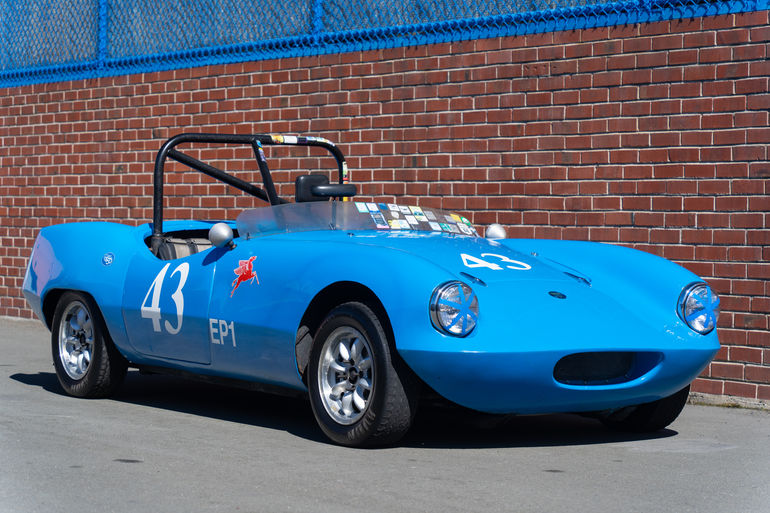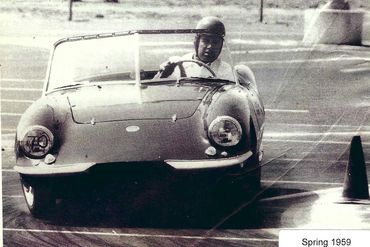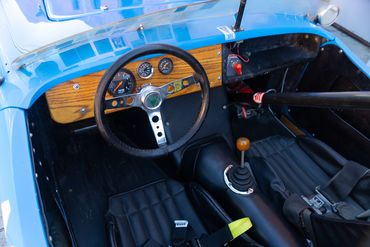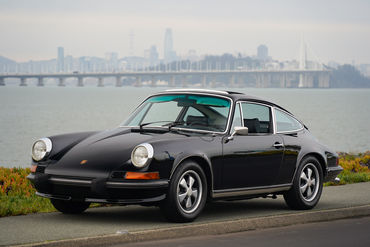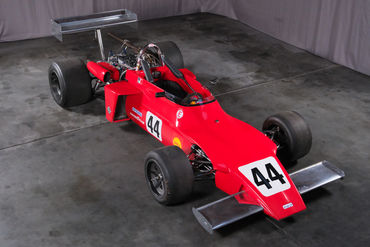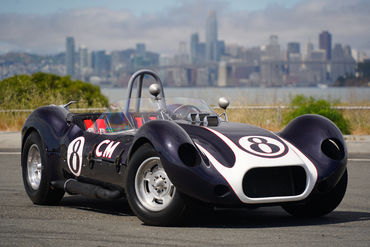Sold
SOLD 09/22
1959 Elva
Courier race car
Bring a Trailer NO RESERVE auction in progress: Well-known California Courier. Great intro to vintage racing. Large spares package.
- VIN100/52L
- Exterior ColorBlue
- Interior ColorBlack
- MileageTMU
- Engine1.6L inline 4-cylinder
- Transmission4-speed manual
- StatusSold
- StockFJ2637
Description
1959 Elva Courier
Chassis No. – 100/52L
Exterior Color – Blue
Interior Color – Black
Engine –1,622cc MGA 4-cylinder
Transmission – MGA close ratio 4-speed
General Overview
Founded in 1954 by Frank Nichols, when his prototype was test driven for the first time, the driver returned from his run gleefully announcing in French “Elle Va” (she goes!!). Nichols, enchanted by the proclamation, named his cars and company after that distinctive phrase. In a few short years Elva would become one of the more competitive lightweight racers of the era, recording win after win during the 50s and 60s. Going head-to-head with Lotus, Lola, Marcos, Peerless, and Turner, the Elva held its own, winning races and a loyal following. By 1957 Nichols was successfully selling sports-racing and formula junior cars in the UK and the USA, fielding an Elva Engineering factory team, and finding success with many privateers. Powered by a range of engines from the early side valve Ford to sports-racers powered by Porsche and BMW engines, and to the big V8 McLaren-Elva CanAm cars, the lightweight Elva MK series with its space-frame chassis, independent suspension, and reliable power plants were favorites among racers that wanted lightweight cars with attractive bodies featuring the latest in technological advancements.
Early in the company development, the Elva Courier was conceived as a larger volume car primarily as a means to fund larger racing efforts. Essentially the only Elva specifically produced for both race and road provisions, the Courier was offered as a complete car or in kit form. The two-passenger roadster featured a lightweight fiberglass body and an MG sourced drivetrain. The first 50 or so cars were produced with a V shaped windscreen, a feature that would later yield to 400 or so more Couriers produced with a proprietary curved windscreen. The Courier endeared many Elva enthusiasts due to the versatility and ease of use, particularly as an effective race car, one that offered substantial value and dual-purpose enjoyment – features that continue to be appreciated by collectors and enthusiasts alike.
History of This Car
This Courier is chassis number 52, part of the original series of first production units assembled with the distinct and rare V shaped windscreen. Believed to have been originally painted red, Bruce Gilbert, a noted Elva historian, notes that this car is one of approximately ten delivered to Northern California, and the only one finished in red. It was first raced by Bob Peter Potter, who competed in both autocross and road races. The next owner is believed to have been Ivo P. Rile who is known to have raced a red Elva in both Northern California and Nevada, including participating in the 1963 Oakland Grand Prix. Other evidence of early SCCA racing participation include photos depicting the car with towing modifications and rollbar, both of which were with the car when purchased by the current owner.
After early racing history lapsed, the car was street driven, modified with fender flares, and then sold to Ruth Plascjak residing in Lafayette, CA (1971 CA registration card copy included with car). Shortly thereafter, well-known sports car enthusiast and collector Jarl deBoer purchased the car, then sold it to Earl Pierce, who would go on to race it in various local autocross events. Eventually Pierce sold the car to Elva expert Butch Gilbert in exchange for restoration services on another Elva. The current owner purchased the car from Gilbert in 1995. Under current ownership, beginning in 1995, the car was restored including stripping the body shell down to the gelcoat, revealing the original red color in the restoration process. With the body removed, the bumperettes and turn signal indicators were removed and the mounting holes were properly filled with fiberglass. Also, during the restoration, the welded frame segment added to facilitate towing was properly removed and the frame tubes correctly refinished.
With the body work and chassis restoration underway, the engine was removed and rebuilt. The crankshaft was knife-edged, nitrided, and balanced. Carrillo rods were installed along with JE pistons, the camshaft given a “circle track” grind, and the stock exhaust manifold was replaced with tubular headers. All rubber and metal fuel lines were replaced, the car was completely rewired, and the generator updated to a newer alternator. A pair of fiberglass seats with slip-over bolstered covers were installed for the interior along with a new dashboard outfitted with a tachometer, water temp and oil pressure gauges, and a mechanical oil temp gauge. A set of heavy duty dual bearing hubs and axles were installed running a 4.22:1 ratio clutch-type limited slip.
The restoration was completed in March 1996 and accepted by CSRG March 15 where it raced at the CSRG Spring event at Sears Point, March 29-31. After the restoration was completed and initial racing commenced, a series of changes were performed to the car including progressive improvements as noted with each year:
- Rear trailing arms were replaced with rods and Heim joints.
- Roll bar replaced (per SCCA request) to taller, thicker “Petty” bar (work performed by McGee Motorsports at Sears Point 1997
- 1997 shock/coilover mount perch relieved and welded, reinforced on both sides
- 1999 new braided steel brake lines. Replaced Spax shocks with Carreras. Corner weights done with 25% at each corner (total weight 1531 lbs).
- 2001 Suspension pieces magnafluxed, rear toe-in and camber checked.
- 9” front drums replaced with 10.2” discs initially but changed to 9.5” versions in 2000 due to 1962 date requirement.
- 2004 front rubber bushing A-arms replaced with newly made A-arms and Delrin bushings.
In 2006, Ron Middlebrook offered a spare engine for rebuild when the former engine developed an irreparable crack. Seven-time autocross winner and engine builder Bob King rebuilt the motor. The engine built at that time included 12:1 compression .040” overbore, running an APT Vintage race cam, Rimflow valves, and Saenz rods. In 2007 the engine suffered a main bearing cap failure causing the engine to seize. Stitch-n-Weld, Turlock, CA repaired the block which was run until 2010 until that motor was changed in favor of a new unit.
After years of racing and wrenching, the owner amassed significant and valuable information on engine performance and durability. Seeking to find the right combination of durability and performance, the owner elected to run a fresh engine using lower compression with tolerances that allowed for .080” piston protrusion using a .120” Cometic steel gasket resulting in 10:1 compression. The head was flowed, the ports matched and polished, and a B series steel billet cam installed. Hardened valve seats for 100 octane unleaded race fuel were prepared, though with the Cometic gasket, it’s likely able to run on premium pump gas. The owner reports that the clutch and oil cooler were replaced approximately 12 events ago, the 4.22 rear end was rebuilt approximately 12 events ago, and the electric fan was replaced 4 events ago. Compression readings recently taken returned the following numbers - Cylinder #1 – 183, Cylinder #2 – 182, Cylinder #3 – 175, Cylinder #4 – 185. Over the ensuing years, supported by dozens of professional mechanical service invoices, detailed notation on engine and drivetrain services, and numerous races as documented in the eight racing logbooks accompanying the car (1996-2019), this Elva Courier has won the following awards and honors:
1996 Time Machine Award for period-authentic preparation, USRRC Seniors Tour at VARA event in Pomona.
1997 and 1998 Season championships in VARA group EP1.
2000 Sonoma Historics - Best in Presentation and Performance in group.
1999, 2000, 2002, 2003, 2005, 2006 Participant in Monterey Historics.
General Condition
Today this historically important Elva MK IV is presented in good condition, reflective of typical race car cosmetics which have aged very well since the restoration work performed some years ago. The refinished fiberglass body displays panel fit reflective of older fiberglass construction but maintaining generally good contours. The finish is glossy throughout, and no significant marks of note mar the body surface. Displaying all the qualities of a durable participant for future vintage events, the windscreen has become a bit foggy, there is paint wear in the door jamb areas, and the wheels display some aging to the finish. The fixed headlights, rear lighting, and Mobil Oil Pegasus logos combined to make a handsome sports racer profile. The rollbar is finished in black, displaying multiple entry stickers echoing the many vintage racing events signed off in the logbooks. #43 adorns the hood, doors, and hinged deck lid.
The cockpit is spartan but clean with easy access to the shifter and foot pedals. The gearbox currently fitted is an MGA close ratio with 1st – 2.45:1, 2nd – 1.68:1, 3rd – 1.27, and 1;1 4th gear. A pair of matching black seats are fitted with competition five-point seat belts of different brand and age. A fire suppression system is also professionally installed. A varnished wood panel dashboard hosts three instruments with four functions, a few switches, and an Elva branded steering wheel. Clearly the goal of lightweight construction when built, the car has been enjoyed as intended and interior details are reflective of that spirit.
Under the hinged hood, the MG engine is fitted with twin SU carburetors and tubular headers. The compact engine is topped by a finned alloy MG cam cover and fitted with a modern alternator. The car retains the original Elva Engineering chassis plate indicating the name, number, and original engine number assigned to the car. The small, hinged trunk opens to reveal a compact FuelSafe fuel tank with anodized fittings. The underside reveals wood panel floorboards, steel frame construction, and finishes consistent with the preparation and use of an older vintage race car.
This is a great opportunity for a vintage racer to acquire a highly capable racecar with nearly 30 years of documented competition history, professional preparation, and early Elva history. Like many of the now vanished British specialty marques, the Elva Courier remains as a unique alternative to the often more commonly seen race and sports cars of this period.
PLEASE NOTE: although this car has been previously prepared for competition use, we recommend that a qualified race shop review the car to determine all systems are appropriately prepared before it is used in a competition setting.
Items Included with the Car
The car is offered with the original V shaped windscreen, two sets of wheels and tires, a third spare set of four rims (boxed), numerous spare engine parts, gasket sets, spare tail light lenses, spare coils, distributors, camshafts, pistons, water pumps, multiple automotive branded stickers suitable for racing livery, the definitive Elva book (forward by Sir Sterling Moss), copies of professional race shop invoices, handwritten notations from the owner documenting much of the technical details for the drivetrain, eight racing log books, and a host of other miscellaneous electrical and mechanical spares.
The above vehicle information is complete and accurate to the best of our knowledge at the time it is posted to this website. Corrections or additional information is always appreciated. All advertised prices exclude government fees and taxes, any finance charges, any dealer document preparation charge, and any emission testing charge. Vehicles are subject to prior sale. All advertised to be true but not guaranteed. We assume no liability for errors or omissions.
Inquire About This Car
Fantasy Junction • 510-653-7555 • 1145 Park Ave, Emeryville, CA 94608
